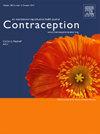Three-year efficacy, safety, and tolerability outcomes from a phase 3 study of a low-dose copper intrauterine device
IF 2.8
2区 医学
Q1 OBSTETRICS & GYNECOLOGY
引用次数: 0
Abstract
Objectives
This study aimed to assess 3-year efficacy, safety, and tolerability of the Cu 175 mm2 intrauterine device (IUD).
Study design
This single-arm trial recruited participants at risk of pregnancy aged 17 to 45 years at 42 U.S. centers to receive a Cu 175 mm2 IUD with a flexible nitinol frame. We assessed efficacy in participants aged ≤35 years at enrollment and assessed all other outcomes in the entire population. We calculated the Pearl Index (pregnancies/100 person-years) through 3 years as the primary efficacy outcome. The secondary outcomes included pregnancy percentages by life-table analysis, placement success, safety (adverse events), and tolerability.
Results
Of 1620 enrollees, 1601 (98.8%) had successful IUD placement, with 1397 aged ≤35 years at enrollment. We observed a 1-year Pearl Index of 0.94 (95% CI 0.43–1.78) and 1-year and cumulative 3-year life-table pregnancy rates of 1.26% (95% CI 0.57%–1.95%) and 2.47% (95% CI 1.34%–3.60%), respectively. The most common adverse events included bleeding and pain. Over 3 years, 15.4% of participants discontinued due to bleeding or pain. Device expulsions occurred in 36 (2.2%) and 63 (3.9%) participants over 1 and 3 years, respectively. Eight related serious adverse events occurred, including five ectopic pregnancies and one each of uterine perforation, anemia, and uterine hemorrhage. One- and three-year continuation rates were 78.9% and 49.6%, respectively.
Conclusions
These data support efficacy, safety, and tolerability of the Cu 175 mm2 IUD during the first 3 years of use.
Implications
In this Phase 3 trial, the investigational Cu 175 mm2 demonstrated efficacy, safety, and tolerability with low rates of expulsion and discontinuation for bleeding and pain-related symptoms. This flexible, nitinol-framed, low-dose copper IUD comes preloaded and would expand contraceptive options beyond the single nonhormonal IUD currently available in the United States.
Clinical Trial
NCT03633799
低剂量铜宫内节育器 3 期研究的三年疗效、安全性和耐受性结果。
研究目的评估 Cu 175mm2 铜宫内节育器 (IUD) 的 3 年疗效、安全性和耐受性:这项单臂试验在美国的 42 个中心招募了年龄在 17-45 岁之间的高危妊娠者,让她们接受带有柔性镍钛诺框架的 Cu 175mm2 宫内节育器。我们评估了入组时年龄小于 35 岁的参与者的疗效,并评估了整个人群的所有其他结果。我们计算了 3 年的珍珠指数(怀孕/100 人-年),作为主要疗效结果。次要结果包括通过生命表分析得出的怀孕百分比、置管成功率、安全性(不良事件)和耐受性:在 1620 名注册者中,1601 人(98.8%)成功放置了宫内节育器,其中 1397 人在注册时年龄小于 35 岁。我们观察到 1 年的珍珠指数为 0.94(95%CI 0.43-1.78),1 年和累计 3 年的终身妊娠率分别为 1.26%(95%CI 0.57%-1.95%)和 2.47%(95%CI 1.34%-3.60%)。最常见的不良反应包括出血和疼痛。3 年中,15.4% 的参与者因出血或疼痛而中止治疗。在 1 年和 3 年中,分别有 36 名(2.2%)和 63 名(3.9%)参与者发生了装置脱落。发生了 8 起相关的严重不良事件,其中包括 5 起宫外孕,子宫穿孔、贫血和子宫出血各 1 起。1年和3年的持续率分别为78.9%和49.6%:这些数据支持 Cu 175mm2 宫内节育器在最初 3 年使用期间的有效性、安全性和耐受性:临床试验:NCT03633799。
本文章由计算机程序翻译,如有差异,请以英文原文为准。
求助全文
约1分钟内获得全文
求助全文
来源期刊

Contraception
医学-妇产科学
CiteScore
4.70
自引率
17.20%
发文量
211
审稿时长
69 days
期刊介绍:
Contraception has an open access mirror journal Contraception: X, sharing the same aims and scope, editorial team, submission system and rigorous peer review.
The journal Contraception wishes to advance reproductive health through the rapid publication of the best and most interesting new scholarship regarding contraception and related fields such as abortion. The journal welcomes manuscripts from investigators working in the laboratory, clinical and social sciences, as well as public health and health professions education.
 求助内容:
求助内容: 应助结果提醒方式:
应助结果提醒方式:


